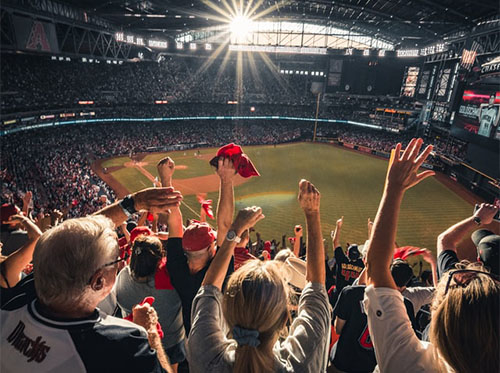The Future of Livestreaming: Music and Sports
Today marks our third installment of the RockWater Roundup.
What’s In This Episode
There have been a handful of recent livestream deals in music and sports. NBCU tapped Twitch to produce and deliver live content that will live on a new NBC Olympics Twitch channel for the 2021 Tokyo Olympics. And Warner Music invested in virtual concert platform Wave, and Deezer invested in live concert platform DREAMSTAGE. We break down the power of “live” via 4 success pillars, and how livestreaming will impact the future of these two verticals.
Subscribe to our newsletter. We explore the intersection of media, technology, and commerce: sign-up link
Learn more about our market research and executive advisory: RockWater website
Email us: rounduppod@wearerockwater.com
You can listen, subscribe, and follow our show on:
Our ask: wherever you listen, and particularly on Apple Podcasts, please give us a rating and write a short review. And forward this email to a friend. Doing so will help others discover the RockWater Roundup.
Episode Transcript
The conversation was lightly edited for clarity.
Chris Erwin:
Andrew, have you been tracking some of the Livestream deals over the past couple of weeks? I think I saw something about Twitch and NBCU and Warner buying a stake in Wave. You’ve been tracking this?
Andrew Cohen:
Yeah. No just over the past couple of weeks, but it seems like ever since the beginning of lockdown last March, we’ve been seeing more and more Livestream news happen every week.
Chris Erwin:
It’s pretty wild. Yeah, we actually have a little shout-out to our website. If you go to one of our blog posts, we have a Livestream watch list. You can go see all the recent fundings out over the past year, 18 months or so.
Andrew Cohen:
Always be plugging.
Chris Erwin:
Always be plugging. Okay. There’s a few that stood out. So one in particular was this partnership between NBCU and Twitch, and so NBCU has the exclusive live rights to the 2021 Summer Olympics in Japan. And so NBC is tapping Twitch to produce and deliver live content that will live on a new NBC Olympics Twitch channel for the summer games. It’s going to include Olympics theme content. It’s going to have daily unique Twitch-produced content, such as daily interactive clip shows, daily competition among three teams of Twitch creators, and primetime side casting and a live from Tokyo segment. I think there’s a cool quote from one of the deal-makers here that says “The way that people consume traditional sporting events is changing. They no longer want to simply spectate. They want to be as close to the action and athletes as possible, and that’s what Twitch is bringing to the mix.”
Chris Erwin:
Just a couple of other quick deals. Warner bought a stake in a virtual concerts platform called Wave, and a Paris-based music streaming startup called Deezer took a minority stake in DREAMSTAGE, a live music streaming startup. So a lot of activity here, and I think, Andrew, something that you’ve thought a lot about and written about is, why is this happening? And you’ve captured four interesting pillars, so I think it could be fun for you to break that down for our listeners here.
Andrew Cohen:
So, really what we’re saying is that across all these different verticals, live media is becoming more and more valuable. We think that live media is defined by four pillars, all of which evoke a deeper level of audience engagement and thus valuable.
Andrew Cohen:
Pillar number one, it’s moment driven, which drives tune in. So the fleeting nature of live content and of live moments creates a sense of urgency for viewers. Each live event holds the potential for a completely unique moment, a new unique experience, so you tune in. There’s real urgency around that versus something that’s on-demand.
Andrew Cohen:
Pillar number two, we’re calling the FOMO factor, which drives lean in. So it’s that fear of missing out on a memorable moment that keeps users glued to the action because the next moment may always be that “can’t miss” moment that everyone’s going to be talking about, which is why in part consumers watch live video for 10 to 20 times longer than they do on-demand content.
Andrew Cohen:
Number three, authenticity, which drives form of connection. It makes users connect. Really, live content is, by nature more authentic as opposed to scripted dramas on HBO or the meticulously rehearse and edited videos on TikToK, or even the highly dramatized reality shows on TV. The memorable moments that make live entertainment special tend to be organic and unscripted, and this authenticity evokes a deeper and more intimate level of audience connection, which is just the ultimate currency. Live video, it engages viewers in this immediate and authentic way that other format just can’t. We see that with podcasting as well, where it’s known as just a really immediate and intimate medium, and because of that, advertising is more lucrative there because it fans really feel like they’re connecting with the hosts.
Andrew Cohen:
And wrapping it up, pillar number four is that it’s social, which causes users to share. So viewers feel like participants in live content rather than just passive observers. The communal experience of live consumption to a group of friends and strangers with a common passion engaged in a shared moment, it’s inherently social. So from watch parties, to water cooler recaps, live events have always inspired communal engagement, and now social media has become the world’s biggest watch party, the most active water cooler. And so, viewers, they share clips and they discuss content in real-time across social media, promoting the event by not only evoking the sense of FOMO in those who aren’t launching it, but also by inspiring those who are watching to engage more deeply and contribute their own point of view to the conversation.
Andrew Cohen:
On a typical Sunday afternoon in the fall, the top 30 trending topics on Twitter are all related to the NFL games that are underway. This unique interactivity of the live medium, I think amplifies this already heightened form of audience connectivity and just results in a collective level of sustained engagement and real time peer-to-peer promotion that’s nearly impossible to replicate on static on-demand mediums.
Chris Erwin:
Cool. I really like those four pillars. I always say, Andrew, I think you have a knack for putting things into a really clear framework for our listeners or readers, so kudos on that.
Andrew Cohen:
Well, thank you.
Chris Erwin:
We describe what’s happening in deal activity in this space. You just explained why there’s all this activity with these four pillars. So I think what’s now most interesting is how is Livestreaming going to evolve different industries? And so we’ve seen a ton of different capital flows, as well as partnerships, around a lot of different industry segments, in sports, in social media, in shopping, in music, in fitness and so much more. That can easily take a whole nother three-hour podcast. I think what we want to focus on for today is specifically targeting music and sports.
Andrew Cohen:
Don’t get us started on Livestream shopping or this microcast will quickly become a macrocast.
Chris Erwin:
Yeah, that’s true. We’re going to save that for probably not one single microcast, but a bunch of others. So let’s dive into music and sports. This is cool. I’ll talk about music. A peer had sent me a demo of their new, I think, alpha or beta product over the weekend. It’s a virtual VR concert startup. I felt like the energy that it evoked from its technology was so cool, got me more excited about the space. In speaking of frameworks, I think for music, there’s three things that stand out that I see. Scale and speed, personalization and access, and new revenues. So let’s just quickly dive into those.
Chris Erwin:
Scale and efficiency. I think there’s a lot less financial and physical burden on the artists who can perform in front of millions of fans in multiple countries all in a single event, and they can even stand up shows to meet new demand rather quickly and at lower costs. I think there’s a great example that we were talking about before, that’s with Travis Scott breaking down. Let’s talk about his live touring schedule in 2018 to 2019. 55 live shows over four months of travel, reach 850,000 fans and grow 64 million in revenue. Now let’s compare that to his 2020 Fortnite shows, four virtual shows, one weekend, no travel reach, 28 million fans. That’s like a 35X multiple relative to his previous live tour and 20 million in revenue. So when you compare just the time and commitment versus the revenue, it’s really, really compelling.
Chris Erwin:
I think there’s also an angle that it goes like the same things for the fans. Fans who spend so much time and money on getting to a venue, whether it’s driving there or flying across borders. Now with virtual concerts, more time and money can be spent on enjoying the moment with the artists and supporting the artists versus the getting there. And I think that supports a whole bunch of new revenues.
Andrew Cohen:
Yeah, and I think it’s important to realize too that, much like all live streaming, it’s not one or the other. I really think that there’s a world where the two can be complementary. We saw earlier in the year Fortnite announced that they’re opening up an island that’s just for live concerts, and they want it to kind of become a new destination, a new stop that artists have on their tour. So they could do 55 live shows around the world like Travis Scott did, but then also do a few shows on Fortnite, and the two can be complementary. You can start off with Fortnite to reach a massive audience and reach new fans, promote an upcoming tour. And then maybe that will inspire fans to come out and buy tickets to see you in person when you come to their town, can really be synergistic that way.
Chris Erwin:
100%. So a couple of quick hits before we get over to you on sports and before we run out of time here. Second is personalization and access. So think about experiences that fans can’t get at live concerts or festivals, right? Easy access where you can go see multiple brand activations. You can go see multiple different stages within a shorter amount of time instead of being like, “Oh, I got to walk 30 minutes to this other stage.” You get VIP access. You can get backstage views. I’ve even starting to see developments around enabling climbing up the equipment on the stage or doing stage dives in a virtual environment. Something maybe you’d never do in real life, but that you want to experience virtually, go ahead.
Chris Erwin:
And different ways to express yourself. Imagine if you go to different types of shows, like you’re a metal head or you’re an emo head, and then you want to go see an Eagles concert. You can have different avatars, different dance moves, different ways to express yourself, different identities for each of these shows and events. I think that’s really cool.
Chris Erwin:
And then a third one, on new revenues for advertisers, like we broke out with the Travis Scott Fortnite example, you’re reaching a greater audience and that adds value to advertising inventory. You can actually start to create more digital activations that can wrap the event, like virtual storefronts, sponsoring live chat feeds. Another one, you can do a la carte ticketing. So maybe instead of buying a ticket to the entire show, you just want to go for the last 30 minutes and the finale. Buzzer’s doing this in the sports space. Maybe that happens for live music.
Chris Erwin:
And then all the virtual and digital goods, seeing things like, you want artists selfies, you want artists hangout sessions after the show, you want to have maybe digital fashion for the event. So we’re talking about RTFKT and their digital sneakers. Maybe that supports a whole new digital fashion movement within the live music and even NFTs of special concert moments. And lastly, Bandsintown, which was a band discovery platform, they now have a subscription package. It’s like the class pass for music. So all these new revenue streams, there’s a million more things to talk about. But I want to make sure that you have time for sports because there’s some cool stuff there.
Andrew Cohen:
In sport, Livestreaming is going to be a game changer as well. I think it’s really going to be crucial for supporting two growing priorities for sports and broadcasters. It’s growing Gen-Z fandom and growing gambling revenues. So when it comes to Gen-Z fandom, it’s important to note the average age of audiences for NFL, MLB, and NCAA basketball football is 53 years old.
Chris Erwin:
Wow. That’s older than I would’ve thought.
Andrew Cohen:
Yeah, me too. Then you juxtapose that with eSports where 79% of fans are under the age of 39 and where 68% of Gen-Z males agree that gaming and eSports are an important part of their identity. You really have to look at eSports as kind of a model for maybe what the next generation of a broadcast experience looks like when it comes to Livestreaming, especially when you consider that 80% of eSports fans watch online via Livestreaming, whereas traditional sports viewership is the exact inverse. It’s 80% on traditional linear platforms. So as everything shifts towards Livestreaming, really think that eSports is going to be an important playbook for traditional leagues to follow to reach the next generation of fans.
Andrew Cohen:
So the content experience on eSports can really be broken out to three main pillars. It’s personalization, gamification, and social interactivity. On personalization, it’s things like allowing the viewer to select their camera angle, change the interface, change the color of commentators, track certain players of interests. On gamification, you can reward viewers for interacting with the stream with extensions to let fans predict gameplay, like who’s going to score the next goal, test knowledge with trivia, compete with other fans on leaderboards. On social interactivity, you can encourage fans to cheer using teams-specific bits and emotes inside a chat window and reward this engagement by a lot of participants to unlock new emotes and bits to cheer for their team and to express their fandom. Something that we’re seeing big in the eSports world that can definitely be applied to traditional sports as well.
Andrew Cohen:
And then within all of this, it opens up all these new monetization strategies. We’re seeing with eSports the sale of physical and digital items easily integrated throughout the stream, much like Livestream shopping. Given just the size of the eSports audience, with even just a 1 to 3% conversion rate, this revenue could soon become a bigger part of eSports revenue than advertising this right now. So already we know how much merchandise factors into the traditional sports revenue pie, and Livestreaming can really unlock this.
Andrew Cohen:
Quickly on betting, really Livestreaming can unlock a whole new wave of live in-game betting. Right now in Europe, 70 to 80% of sports betting revenue already comes from in-play gaming, and as regulation relaxes in the US, we think that this could become even more prevalent here. It’s going to be totally enhanced by Livestreaming. This could include free to play gaming for younger audiences and kind of these curious top-of-funnel potential betters, but also live betting integrations backed by Sportsbook partnerships, totally integrated within the Livestream. We’re already seeing this emerge in the US, the recent partnership with the PGA and NBCU and Sportsbet where you can bet on a hole-by-hole basis right within the Livestream itself, and even on a free play basis with the match, the Tiger Woods versus Phil Mickelson event on the Bleacher Report app, where there was a lot of kind of side-betting and gaming going on integrated into the experience.
Andrew Cohen:
So really, definitely think that Livestreaming is going to be a huge game changer for how people experience sports viewership.
Chris Erwin:
Awesome. Well, Andrew, I think we’re backed up against our 15-minute wall. So we’ll just have to schedule more microcast to get into more topics here.
Andrew Cohen:
Till next time.
Chris Erwin:
Till next time. Later.
—
Ping us here at anytime. We love to hear from our readers.



